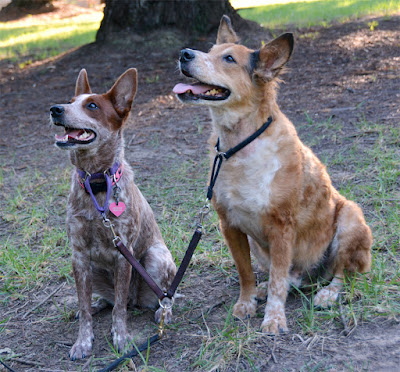 |
| Photo by Erin Koski |
Couplers...
I picked this coupler up at a thrift store several years ago because it was leather and pretty and had a manufacturer's mark on it. It spends a lot of time in a drawer, but sometimes makes it into my training bag for use as a safety device. See, it's basically a short strap with a snap at either end. This makes it a perfect safety device for escape-artist dogs, as I can clip to to a head halter, harness, slip collar, or to the snap on the leash.
Unlike this completely ridiculous three-way coupler, the Hamilton leather coupler is short enough to keep two dogs relatively close together. It keeps either dog from stepping over their leash, but it also means they need to move well together. The first time I actually hooked two dogs together with this coupler, it was foster puppies Darla and Hellin. We were headed for some off-leash recreation and I just needed to get them from the car to the fenced area of the park. Neither was particularly good at walking on leash at that point, and I figured I'd simplify things a bit by hitching them together so they'd cancer each other out.
Physics!
Know what happens when two dogs on one short coupler run to the end of their shared leash? Their bodies attempt to occupy the same space, the coupler swings them together, and their heads knock together. (I'm told the same thing happens when you buckle two kids in the same seatbelt and the car stops fast...) If these are particularly goofy puppies who are overly-excited, they may repeatedly bounce to the end of the leash and whack their heads together over and over again until separated.
With less ridiculous dogs, couplers can be ok. I used to walk a friend's totally chill older labradors on short couplers with no issue because the dogs did nothing but plod along and stop for an occasional sniff. They were also pretty untroubled by their coupler-buddy stopping or starting or moving suddenly, and I coupled them together in pairs that tended to move at the same speed since they needed to coordinate a bit. Brisbane and Sisci walk very well together, but I do not use a coupler with them because I like to be able to communicate individually with them via their leashes. They are both sensitive dogs, and would be unhappy having another dog randomly pulling on their collar or harness. My dogs are also somewhat prone to sudden movement, which can be unpleasant for their coupler-buddy.
Pros: Short enough to keep two dogs close and prevent leashes from getting underfoot. Ridiculously strong with relatively light hardware. Totally pretty. Works great for attaching gear to other gear to prevent escapes.
Cons: Short length means it can only be used to couple together two dogs of similar size, speed, and activity level.
Bottom Line: Great as a safety tool, also great for well-trained, predictable, relaxed dogs.
Have you used a coupler with multiple dogs?
No comments:
Post a Comment